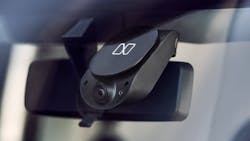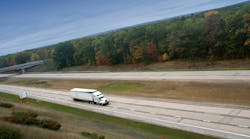Driving fleet safety forward: Implementing telematics, cameras, and driver training
Key takeaways
- Leadership support is crucial for successful adoption of safety technologies, setting the tone from the top down.
- Involving multiple departments ensures comprehensive safety programs that address various organizational concerns.
- Immediate response to data insights and driver behavior feedback are key to effective safety improvements.
- Messaging should focus on vehicle health and driver well-being, not just punitive measures, to foster acceptance.
- AI can enhance risk detection but requires human validation and ongoing policy adjustments for optimal effectiveness.
The details of adopting telematics, camera systems, and driver training programs are important and require diligence in finding the right technology partners, but that’s the second step: The first is the decision to invest in and commit to a fleet safety upgrade.
That’s among the takeaways from a recent NAFA Media Connection conference call featuring a pair of fleet representatives who’ve just implemented new safety technologies.
“It has to be from the top down,” said Phil Moser, manager, driver training, Davey Resource Group. “If the guy who runs the company says, ‘we're going to do this,’ we do it.”
Committing to fleet safety starts with executive leadership and buy-in
In an interview for his current position, as Moser recalled, the executive explained that Davey has people in the field who deal with keeping utility poles and power lines clear, “and his words to me were, ‘but the thing that sends them to the hospital most is traffic crashes, and we need to fix this.’ Wow. Okay, this guy gets it. How do you not invest in safety?”
For Levi Clark, fleet and transportation manager for the Port of Seattle and a NAFA board member, the key is for division leaders to “get out of our silos.”
“The most important thing you can do in any organization is get more teams involved,” Clark said. “I tried to involve environmental, risk, safety, legal, HR, in a lot of my new ideas for programs, and I get their input and their feedback. I also get them excited. But you need to have a firm business case for why you're doing it: Really sit down and put together an executive-level summary of this and why it's important to the organization.”
Responsibility for executing a new safety program built around telematics and camera systems trickles down to the field-level managers, Moser noted. “They can make or break it.”
Beyond that, it’s a matter of being prepared to act immediately when the data starts coming in.
“There are challenges, as with any launch of any safety initiative, but we're overcoming them,” Moser said. “And, as a result, we already see some pretty positive results.”
Clark agreed and reiterated the importance of emphasizing the benefits of these systems.
“The way we message our rollout of this technology in our fleet is, one, for the health of the vehicle, because we need to maintain the vehicles appropriately, on the right cycles. We need the vehicle safe for the operator,” Clark said. “And then, secondarily, with this telematics and camera program comes driver behavior. How do we turn this technology into a teaching tool and not use it as a stick and a way of punishing people?”
Often, these systems are used to clear the driver in a claim, Clark added, based on his prior experience with a large public fleet.
Indeed, for driver buy-in, such a program shouldn’t be perceived as a “Big Brother” intrusion, Moser suggested.
“This is about changing behaviors; everything we do behind the wheel is a behavior—some of those behaviors are fine, they're safe, and some of them aren't. The cameras are detecting that,” Moser said. “The whole idea behind this is to get you home. The most important thing you do every day is you arrive home safely.”
Integrating AI, policies, and training to improve driver safety and compliance
The conversation also turned to the influence of artificial intelligence (AI) on fleet safety.
The AI integrated into modern cameras can identify risks such as speeding, following too closely, and distracted driving. Moser and Clark are cautiously optimistic about AI's potential to streamline data analysis.
“We're finding that it's not flawless—but again, we have to be flexible. We're learning,” Moser said. “The best safety technology we have in the vehicle is the person behind the wheel. I don't want them to be so dependent on the safety systems or the advanced safety systems that they become lazy and dumb.”
Clark, whose company must also coordinate with union agreements and address privacy concerns, noted that human review remains an essential component to validate AI-flagged events and maintain the human element in safety management.
“We're still going to have conversations,” Clark said, “but I'm excited about AI and the prospects of it.”
This adaptability must also extend to fleet policies, which should be "living documents," created with input from all departments to ensure they are comprehensive yet flexible enough to adapt to new technologies and regulations.
Clark suggested keeping formal policies high-level and using more easily updated "work rules" for specific dos and don'ts. Crucially, once a policy is set, it must be enforced consistently for all employees to maintain its integrity.
Finally, the fleet pros agreed that a blended approach to driver training—combining traditional classroom instruction with hands-on, behind-the-wheel exercises—is most effective, as it caters to different learning styles and reinforces lessons immediately.
Bottom line: Advanced technology is another tool that must be combined with a commitment to culture, policy, and training. But the end goal remains the same: A comprehensive fleet safety program that ensures every driver returns home safely at the end of the day.
About the Author
Kevin Jones
Editor
Kevin has served as editor-in-chief of Trailer/Body Builders magazine since 2017—just the third editor in the magazine’s 60 years. He is also editorial director for Endeavor Business Media’s Commercial Vehicle group, which includes FleetOwner, Bulk Transporter, Refrigerated Transporter, American Trucker, and Fleet Maintenance magazines and websites.
Working from Beaufort, S.C., Kevin has covered trucking and manufacturing for nearly 20 years. His writing and commentary about the trucking industry and, previously, business and government, has been recognized with numerous state, regional, and national journalism awards.





